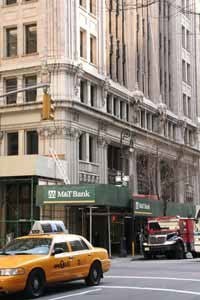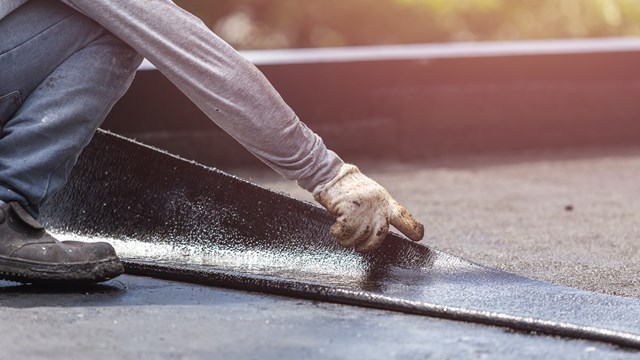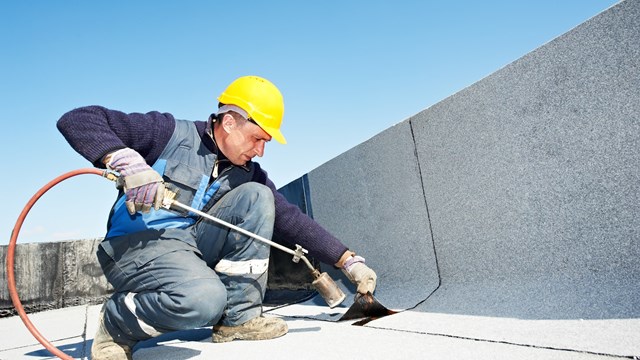
When you walk around busy areas of Manhattan, Brooklyn and elsewhere in the city these days, it's hard to miss the large number of structures stretching above the sidewalk, made up of huge sheets of wood resting on thin metal poles. Most people call them scaffolds, but they are actually known as sidewalk sheds (a scaffold is actually a work platform erected above a sidewalk shed).
On some blocks, it seems that half the buildings have sidewalk sheds. In some locations, the sheds have been up for more than a year—much to the consternation of ground-floor retailers, who consider them bad for business. If you're "lucky," you can even see crews assembling the sidewalk sheds prior to construction or renovation.
But what kind of exterior work is actually being done "up there?"
Up to Code
There are several types of exterior work that are typically done on apartment buildings in the city: Local Law 11 certification work, basic checkups, and work that is done because of urgent conditions requiring immediate attention.
As Department of Buildings (DOB) spokesperson Kate Lindquist explains it, residential buildings must comply especially strictly with sections of the New York City Building Code dealing with maintenance (sections 27-127), owner responsibility (sections 27-128), alterations to residential buildings (27-1021), periodic inspections of exterior wall and appurtenances (RCNY 32-03), and standardization of work permits required for Local Law 11 inspections (TPPN 1/99).
The law places the responsibility of maintaining a building in a safe condition on the building's owner. Buildings over six stories must comply with Local Law 11/98, and the exterior walls of such buildings must be inspected at least once every five years by a licensed professional in order to be considered compliant.
Lindquist adds that there is no "official" checklist for façade work or inspections—the exact methods used are determined by the knowledge and expertise of the individual professional or contractor on the job. She says there are really only two categories of exterior maintenance situations—unsafe, meaning that the work must be done immediately to avoid potential catastrophe; or safe, with a maintenance program that's up-to-date.
Thanks to Local Law 10, (passed in 1980 and since superseded by the abovementioned Local Law 11, which was passed in 1998), says Wayne Bellet, president of Manhattan-based Bellet Construction, "We have a routine five-year program where the exteriors of these buildings [over six stories] have to be inspected and maintained."
Local Law 11 puts a great responsibility on the building owners, Bellet says, but also maintains the aesthetic look of New York City. "For the most part," he says, "both prewar and postwar buildings are all coming due [for necessary exterior work]. They were built from the turn of the last century up to the 1960s and '70s. And 30 to 100 years later, they've given their all, sitting outside all day long exposed to the weather from sub-zero temperatures to well over 100 degrees. They don't have half a chance."
Signs of Trouble
Once façade inspectors or exterior contractors are "up there" on a scaffold, what exactly are they looking for? According to the DOB, if they're inspectors, they are probably looking at the condition of the brickwork, mortar, window frames, flashings (the metal used to cover and protect certain joints and angles, like where a roof comes in contact with a wall), lintels (the metal support strips over exterior windows). They're searching for evidence of stress or shifting, damaged terra cotta, or other problems.
According to Stephen Varone, director of operations for Rand Integrated Engineering and Architectural Services in Manhattan, some of the signs and symptoms of a façade problem are bulges and cracks—especially cracks that extend vertically or that run along a building corner. Also, he says, "spalling" masonry—meaning the chipping or flaking concrete, bricks, and so forth—may tell you that there's water trapped inside. "These are the big-ticket items," Varone says.
Michael Grant of Accura Restoration in Astoria agrees that professionals and contractors are essentially looking at the condition of the masonry and related exterior materials, such as brickwork, mortar, stone, window frames and caulking. He lists some other signs and symptoms of problems—things like bulging or cracked brick, which could indicate damaged steel behind it; peeling paint; exposed rusted steel and bent or sagging lintels. Grant also mentions bricks and other masonry elements being out of plumb—not vertically aligned, in other words—or sticking out at particular points as presenting hazards as well.
This reporter remembers seeing a run-down 19th century apartment house in Brooklyn Heights where the exterior wall, in one place, was extending more than six inches from plumb. Eventually, after a heavy rain, bricks began falling down on passersby, and the building had to be temporarily evacuated with emergency work ordered by the Building Department.
Discoloration of bricks, too, can indicate a problem, as can appurtenances, such as air conditioners, that are improperly installed. In general, if it looks like something is wrong, it's time to examine it.
How to Fix it
What are the most typical repairs done on New York City's residential co-ops and condos? Depends on whom you ask. Lindquist says that repairing loose or chipped bricks, re-caulking and replacing the mortar joints between bricks (often called "re-pointing") replacing windows or bulging bricks, and cleaning masonry are some of the more common types of exterior maintenance and repair jobs in the city.
Bellet, whose company has been in business for 90 years, agrees about re-pointing. "The mortar in between the bricks gets washed out or eroded through water flow or aging." Bellet compares re-pointing—which entails removing the old, unsound mortar down to a certain depth, mixing up newer, stronger cement and using it to repair the gaps, "to going to the dentist," aside from the fact that workers often dangle from a hanging scaffold to carry out the job.
Bellet also adds lintel repairs to the short list of most-common exterior jobs. "The steel lintel," he explains, "is a component located over each and very window. It holds up the brick, and if you didn't have it, the bricks would come tumbling down. It's also a waterproofing and a weight-transferring device." If a lintel has deteriorated or become compromised in some way, it's one repair you don't want to leave for a rainy day.
According to Varone, the most common type of work deals with masonry in general, whether it's brickwork, stone work or pointing. "That's your garden-variety exterior restoration project," he says.
Michael Wolfe, president of Midboro Management in Manhattan, concurs: "Most of the work includes re-pointing, brick replacement and waterproofing. The majority of the projects don't include steel repair or replacement."
Close-Up on the Work
Let's take a close-up look at some particular types of façade work and examine them to see how these kinds of repairs are carried out, what materials are used and how long they take.
One popular type of exterior work, says Bellet, is quarry tile replacement on the city's terraces and outdoor spaces. "A lot of New York City's [architecture] is characterized by setbacks and terraces," he says. "Given their age and exposure, [the tiles] on these spaces often have to be replaced—but sometimes the tile is not the problem. The real issue is the membrane beneath the tile. You have to demolish everything above it to replace that horizontal membrane." Nowadays, he adds, a popular look for terraces is the use of more durable concrete or stone pavers.
Another job that Bellet finds himself doing with regularity is roofing—but he says that the roofing game has changed dramatically from how it was done years ago. "We used to put down the proverbial hot roofs prepared in a kettle. Then we used modified bitumen bought at manufacturer's warehouses prepared with a propane torch," he says. "Now, we've superseded even that with peel-and-stick and even liquid-applied roof systems." Today's roofing materials, according to Bellet, are lightweight, wind-resistant and fire retardant.
One of the other classic types of exterior work, says Varone, is the repair of a parapet wall, or an exterior wall that extends slightly above the flat plane of the roof. "Are you trying to just re-point masonry, put a coating on it to keep the water out, or does it have to be rebuilt?" he rhetorically asks. "In the city, common parapet walls are exposed to the weather and suffer deterioration on both sides." Since replacement is very expensive, the question is—to repair or to replace?
How long do exterior jobs take? Clearly, it depends on the size and scope of a given project. The professionals interviewed for this piece say that a repair could take just one or two days, or it could last for years—a building that has been neglected for years where the caulking and pointing between the bricks is weathering away, the metalwork is rusting and the bricks themselves are flaking and eroding.
And, as in every business, there are a variety of materials that can used for the same situation. Wolfe gives two examples: using cladding (metal sheeting) for the parapet wall instead of re-pointing it; and using an alternative product to replace terra cotta.
Bellet says, "If we're replacing a cornice [an ornamental molded projection that tops many prewar buildings, we can use a fiberglass-reinforced material, we can use a lightweight concrete material, you can use lead-coated copper on your through-wall flashing [used to divert moisture]. It always reminds me of going into the carpet stores—there are different materials, different thicknesses of every material, different price ranges."
Still, he says, "If you're going to call us, we will charge you for the work. To not pay an additional few pennies for better material is foolhardy."
Difficult vs. Easy
What are some of the most difficult types of exterior work? Stonework, Varone says, is a type of work that requires a "high degree of labor skill. The visual result is going to be very important." Wolfe mentions decorative ornamental work, where molds must be used to ensure an exact replica. And Grant points to steel work, such as lintel replacement or lintel repair, as a type of work that "needs to be directed by the owner's engineer or architects."
Bellet's answer might surprise you. "The mortar setting or waterproofing or restoration is almost elementary," he said. "But the hardest part of the project is the rigging—hanging the scaffolding, training the men for OSHA and DOB regulations to protect my riggers' license probably takes the most forethought."
"The work itself is easy—the men are mechanically inclined," he says, "but safety takes more forethought. There is no excuse for sloppy safety."
Raanan Geberer is a freelance writer and editor living in New York City.






4 Comments
Leave a Comment